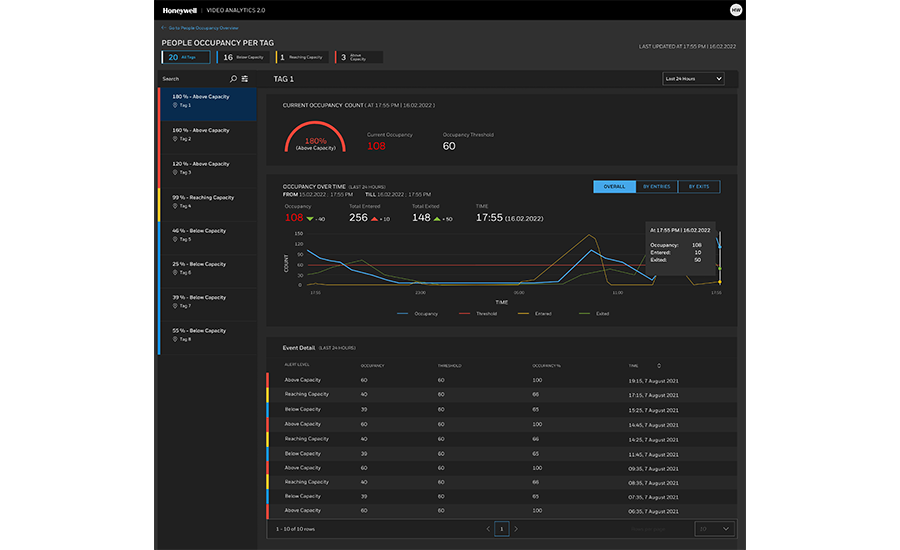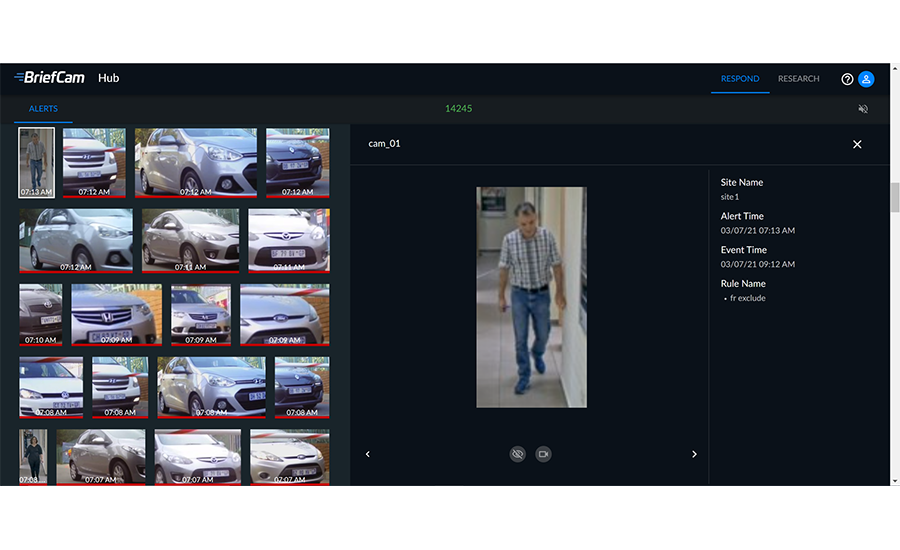Only a few years ago, the promise of video analytics seemed like more sizzle than steak. Interpretation based on pixel motion and algorithms created false alarms, and the unreliability turned off customers. But over the past two years, advances in artificial intelligence (AI), machine learning, deep learning, and edge-based IP cameras have made it more accurate than ever before.
Besides traditional security applications, businesses are turning to video data for intelligence purposes, using predictive analytics, patterns and behaviors, which makes video surveillance and video-verified intrusion detection systems more intelligent and capable of more advanced decisions.
The global pandemic lit the fuse for this growth, with businesses demanding analytics on people counting, mask compliance and more. “Over the past two years, we’ve seen a huge demand for video analytics,” says Jason Burrows, regional sales director, Western U.S., IDIS America, Coppell, Texas. In a recent IDIS survey of more than 400 global security professionals, 85 percent of respondents said they were either already using or planning to adopt some type of AI-powered video analytics.
The SDM 2022 Industry Forecast reflects a similar growth pattern: While 52 percent of respondents said they were currently offering video analytics, an additional 33 percent planned to do so within the next one to five years. And current trends suggest that video analytics technology has barely reached its potential.
“With higher demand in IoT and cybersecurity, video analytics will be adopted at a much higher rate,” says Rick Urban, senior product manager, video systems at Identiv, Fremont, Calif. “With the continued merging of video analytics and cybersecurity, new opportunities will open up in whole new markets.”
Quang Trinh, manager, professional services, Axis Communications, Chelmsford, Mass., says that market research groups expect big growth for the video analytics market; the lowest projections are $12 billion by 2027, the highest at $29 billion by 2029. “As more companies invest in AI technologies and deep learning techniques continue to thrive on an abundance of unstructured data, namely the images and video provided by surveillance cameras, growth expectations will increase,” he says.
“The current market for video analytics is stronger than it has ever been,” says Matthew Cirnigliaro, regional marketing manager, Bosch Security & Safety Systems, Fairport, N.Y. “Analytic features that were once simply sizzle for a demonstration have now matured enough to provide real-world value for users.”

AI technology has made video analytics more accurate and customizable than ever before. i-PRO’s privacy guard function detects and pixelates faces or persons to prevent individual identification. // PHOTO COURTESY OF I-PRO
Beyond Simple Motion Detection
For the past 15 years or so, the first generation of video analytics relied on tracking the movements of pixels on a screen — determining within video frames whether something moved in a scene, says Adam Lowenstein, director of product management at i-PRO, Houston. But changes in weather conditions and lighting could skew this simple motion detection method, often resulting in false alarms. “The end user was turned off because it created a lot of false alarms,” Lowenstein says. “People thought [video analytics] made sense, but they were not always sure it was practical for their use case.”
However, over the last two years, a new generation of analytics, supported by AI and machine learning that allows algorithms to recognize known objects, has created dramatic improvements in accuracy. “The emergence and evolution of artificial intelligence and machine learning has led to the development of new video analytics, such as those based on convolutional neural networks [CNN], that lead to higher performance,” says Steffen De Muynck, product manager, security and ITS, Teledyne FLIR, Wilsonville, Ore. “AI in video analytics represents a shift toward smarter, more reliable threat detection solutions with greater classification accuracy, lower false alarm rate, and expanded situational awareness. AI-driven solutions are part of securing a greater return on investment for integrators.”
The global pandemic accelerated advances such as people counting and mask detection, which manufacturers quickly released to market based on the new needs. “The pandemic didn’t change customer demands, but it did expand them,” says Rebecca Law, director of channel management, BriefCam, Newton, Mass. “BriefCam played an essential role in supporting productive and rapid contact tracing, as well as real-time alerting and long-term reporting for mask wearing and physical distancing compliance. Furthermore, it enabled organizations to analyze guest and staff activity via heat maps or data visualizations to determine the most trafficked areas, allowing hotels, casinos, restaurants, theme parks, cruise ships, and others to benchmark desired occupancy norms and to set alerts to prevent overcrowding.”
At the height of the pandemic, businesses like retailers used people counting and queue management to manage staffing and garner business intelligence — and to comply with COVID-19 occupancy and distancing requirements, says Trinh of Axis. Healthcare organizations used touchless access control and video validation to secure restricted areas while also eliminating surface contact with PIN pads to reduce virus spread, he adds.
Fast delivery of analytics solutions to address pandemic needs spurred video analytics companies to roll out new products faster than ever, where in pre-pandemic days, new analytics products took years to release, Lowenstein says.

The pandemic helped spur interest in using video analytics for business intelligence. Pictured here is Honeywell Video Analytics’ dashboard detailing people occupancy in a retail environment. // PHOTO COURTESY OF HONEYWELL BUILDING TECHNOLOGIES
Big Advantages for Businesses
“Video analytics are a highly flexible technology that can be applied across many different industries,” says Fabio Marti, vice president, marketing at Azena, Pittsburgh, Penn. Logistics and manufacturing use it to monitor and improve operations; retail environments leverage heat mapping to analyze customer flow through stores; and cities across the globe apply video analytics to optimize vehicle traffic flow. Stadiums use it for live monitoring with real-time alerts, such as queue length detection for concession stands during sporting events, and healthcare facilities can leverage fall detection or prevention analytics to protect patients. “This data is not just useful in real time, it’s also optimal for budget and staffing planning to collect specific data over time, such as building occupancy levels, heat mapping in retail settings, or analyzing peak times for passenger volume in a train or metro station,” he adds.
As video analytics applications broaden, end users are demanding more customized solutions tailored to a single purpose, often by adapting existing detection algorithms and retraining models to fit that purpose. “One example is the use of smoke or fire detection analytics to ensure that pumps in an oil field have a constant, clean burning flame to burn off excess gas before it becomes a pollutant,” Marti says. “Another is the deployment of line crossing and object detection analytics in an aquaculture setting to detect and ward off predatory sea birds to prevent fish loss and water contamination.”
Leading the charge for these specialized analytics are AI, cloud, edge cameras and open platforms, which allow users to load third-party analytics from open platform providers onto camera platforms without overburdening the camera with stuff the customer doesn’t need, Lowenstein says. For instance, i-PRO has partnered with third-party analytics providers like Vaxtor (an LPR engine), Databuoy (audio gunshot detection), and others to enhance their end users’ video analytics capabilities.
Robert Oldham, vice president of business development for integrator Stone Security in Salt Lake City, Utah, agrees on the importance of open platforms for video analytics. “It advances the technology quicker and clients can pick the best of breed,” he says. “Our customers prefer and want this.”
But while there’s always a lot of buzz around the power of AI, it is by no means the only tool in the video analytics arsenal, says Bosch’s Cirnigliaro. “AI is a new and exciting tool that is allowing things that weren’t previously possible. However, it certainly isn’t the only tool we have, and others are still very relevant. That’s why Bosch continues to offer all these methods — to provide the most complete solution for as many applications as possible.”
On-Camera Based vs. Software Analytics
Part of video analytics’ tech transformation is attributable to advances in cameras, many of which now are capable of internally performing advanced analytics. “Over the last five years, SOC companies have come up with powerful chip sets that can match the performance of Dell Intel machines and higher GP machines,” says Vijay Dhamija, director of engineering for commercial security, Honeywell Building Technologies, Atlanta. “Cameras are becoming more powerful and can do AI and facial recognition right in the camera. To recognize humans in space, you need good processing power, and cameras can now do that.”
But that doesn’t mean that newer, smarter cameras will necessarily replace servers, he says. “For any new expansions, customers will continue to buy smaller new cameras; but for existing buildings that are not expanding in the near future but still want an analytics solution, they will maintain existing cameras but will gradually replace them with next-gen cameras that are more powerful,” he says. “Both servers and smart cameras are necessary because the total cost of the solution goes down when you start having analytics in the camera. … If you’re investing in smart cameras, the same software will take less resources.”
For instance, while edge analytics reduce bandwidth usage, certain tasks are still best run on a server, such as license plate recognition, which needs to interface with a large database where plates are stored, cross-referenced, and flagged. Hybrid solutions can deliver powerful analytics at a much lower cost, with camera manufacturers providing space on cameras to allow third-party analytics, which can pass data directly to the server. “The continued evolution of AI and deep learning technologies will accelerate both edge and server capabilities to new levels within the security industry and open new markets for these advanced solutions,” Urban adds
Others believe back-end analytics are being phased out because of the increased sophistication of cameras. “There’s a big push, and it’s moving faster than anyone expected,” says Oldham of Stone Security. “If you can get deep learning in $200 to $300 price range cameras, it’s a no-brainer. Deep learning is continuously learning and getting better, and analytics are always being trained and getting more advanced.”

Driven by AI and deep learning, video intelligence software detects and extracts objects in video, identifies each object based on trained deep neural networks, and classifies each object to enable intelligent video analytics. Pictured is BriefCam’s video analytics platform hub, highlighting object detection, identification and classification.// PHOTO COURTESY OF BRIEFCAM
Integrators Benefit With RMR
Advances in video analytics are providing security integrators with more opportunities to expand recurring monthly revenue, too. Integrators can leverage the increased value of video analytics to provide improved service-based offerings for their customers, says Hamish Dobson, vice president, product management, video security and access control at Motorola Solutions, Chicago. These can include centralized alarm detection and response services; maintenance services to ensure cameras aren’t obstructed or out of focus; and outsourced search functions when an incident happens and footage needs to be found. “The use of video analytics speeds up these searches considerably and allows integrators to offer this service to their customers at a lower cost,” he says.
Cirnigliaro of Bosch says there are two primary ways video analytics provide RMR opportunities for integrators: the monitoring model, in which integrators sell video monitoring as a service; and video security as a service, or VSaaS. “In much the same way that we’ve seen the music industry transition from selling individual albums to selling a subscription to a pool of songs, VSaaS allows integrators to sell a surveillance subscription rather than a surveillance system,” he says.
Either way, video analytics can help integrators pivot away from a one-and-done business model.
“Many integrators will sell a video surveillance system, install cameras, then receive most of the money upfront and be done,” says Dean Drako, CEO and founder of Eagle Eye Networks, Austin, Texas. “Cloud is fundamentally an RMR model, generating significant revenue from the customer each year or month to provide the service of recording video in the cloud and running AI on it, or taking care of disc storage. If it’s in the cloud and not on premise, you’re running it, charging a fee, and making more money.”
Tying customers in with more of these services ultimately creates a more valuable business to sell down the road, Drako says. He estimates that RMR businesses are worth 10 times more than those that don’t rely on recurring revenue, with service businesses valued at one to two times revenue, according to investment banking company Imperial Capital.
An Education Process
Although AI-enhanced video surveillance can deliver increased accuracy and more business intelligence than ever before, integrators must understand its capabilities so they can explain it to their customers — and determine if it’s even the right choice for their unique business needs.
“Overselling or overpromising the capabilities of video analytics as a ‘silver bullet’ is still the greatest pitfall today,” says Urban of Identiv. “Understanding the use case and setting proper expectations from the beginning will provide a much better experience for the end user.”
Dhamija of Honeywell says, “Detection is not the only interest from customers; integrators should look at what problems they’re trying to solve. Analytics is just a small piece of the whole game…. If I can solve a company’s problem by sending video to airport authorities, for example, and closing the loop around alarms, not just generating alarms in a system, that’s more important than just selling analytics to these customers.”
Florian Matusek, product group director for video analytics at Genetec, Montreal, believes the security industries is “too focused on the tech side of things” and should instead prioritize actual customer pain points to deliver the best solution.
“In the end, the technology you use shouldn’t matter to the end user,” he says. “What matters is the outcome.… We’re starting with a solution in search of a problem, and it should be the other way around. Talk to the end user, see what their business problem is, then see how to solve it. Sometimes analytics isn’t the answer. First start with the problem.”





